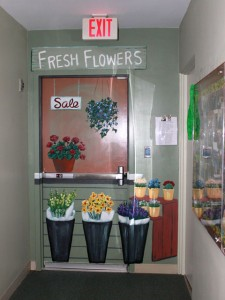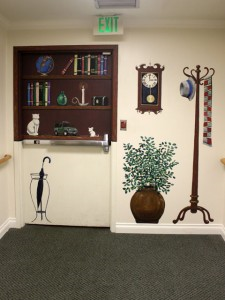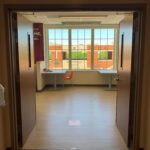I recently worked on a project with some complicated code issues – an assisted living facility in which one level was being changed to a memory care unit. This area of the building would contain apartments for residents with Alzheimer’s disease and dementia. Previously, the lower level (below grade on the front of the building, at grade level on the back) included assisted living apartments and a few amenities for residents, with free access to the exterior. Several paths of egress led through the lower level to the exit discharge.
When I met with the facility representative, architect, hardware consultant, and security consultant, we discussed the preferred level of containment for the memory care unit. For the safety of the residents, a priority for the facility was to prevent them from leaving the building without a staff member (often called “eloping”), and given the low level of staff supervision in these semi-independent apartments, delayed egress locks would not be effective.
I suggested fail safe locks, as allowed by a section added to the International Building Code (IBC) in 2009 – section 1008.1.9.6 – Special Locking Arrangements in Group I-2. This section applies to I-2 occupancies (typically hospitals and nursing homes) where the clinical needs of persons receiving care require such locking, and where the building is equipped throughout with an automatic sprinkler system, or an automatic smoke or heat detection system.
This section requires the following:
- Doors must unlock upon actuation of the sprinkler system / fire detection system.
- Doors must unlock upon loss of power controlling the lock.
- Locks must be capable of being unlocked by a signal from the fire command center, a nursing station, or other approved location.
- Operational procedures for unlocking shall be described and approved as part of the emergency planning procedures.
- All clinical staff shall have the keys, codes, or other means to operate the locking devices.
- Emergency lighting must be provided at the door.
- A building occupant must not be required to pass through more than one door equipped with this type of lock before entering an exit.
- The first 3 items listed above are not required where restraint or containment is required in a mental hospital.
One issue with this plan was that the 2009 edition of the IBC included some incorrect terminology, calling the locks described here “delayed egress locks”. The requirements do not reflect what we in the door and hardware industry know as delayed egress locks – a fail-safe lock can meet all of the requirements of this section of the code. The terminology was changed to “special egress locks” in the 2012 edition, and will be changed again in the 2015 edition – to “controlled egress locks”. In Massachusetts, where this facility is located, we use the 2009 IBC with some state modifications. I met with the fire marshal, showed him the 2009 and 2012 sections with the change in terminology, explained the error, and he agreed to our plan.
To some, locking doors to prevent egress may seem like a step backward. But in some applications, the danger of elopement is much greater than potential hazards of controlled egress. Until now, it has been difficult for memory care facilities to balance the code requirements for free egress or delayed egress, with the needs of their residents. Here is an illustration of the efforts of one facility to prevent elopement:
From the facility’s newsletter: “The emergency exits now appear as a reading nook, a window view, and a horse in her corral. Kudos come from our nursing staff on these disguises. They help our residents to stay focused on life within the unit, and not be distracted or enticed by the doors.” This is obviously not compliant with the requirement for egress doors to be visible, with no decorations.
Note: NFPA 101 – The Life Safety Code, contains a similar section beginning with the 2009 edition. You can read more about locking requirements for I-2 / Health Care occupancies here.
You need to login or register to bookmark/favorite this content.







Where does the what I call “”vicinity lock down” come in??
Patient has fob or something and walks near a door and the door will not open for them
That type of system could work in one of 2 ways…the sensor detects a patient’s wristband (or other credential) and arms a delayed egress lock causing an alarm and 15-second delay if the person attempted to leave, or locks the door in the direction of egress. If it arms a delayed egress lock, it is code-compliant as long as delayed egress locks are allowed in that occupancy type. If it locks a lock, this application was not specifically allowed by code in my opinion prior to 2009. Now that the IBC and NFPA 101 allow doors in some I-2 units to be locked in the direction of egress, this system could be used to lock the door with a fail safe lock. So normal traffic could use the doors for egress, but someone approaching the door with a wristband would automatically lock the fail safe lock rather than initiating a 15-second delay, and it would be acceptable by code rather than requiring permission from the AHJ. It gives us more options without sacrificing life safety.
I would like to have some secured doors put in our community.
What are your thoughts, do you know of any regulations for the state of MN, in regards to placing a locking system on all windows on the memory care unit, that will not allow the window to open at all, unless a special key is used to remove the lock? Do these regulations differ if the memory unit is not on the first floor a of a building? Thank you.
Hi Cristina –
I’m sorry – I am not aware of a requirement like that, but that doesn’t mean it doesn’t exist. Maybe check with the local fire marshal or building inspector?
– Lori